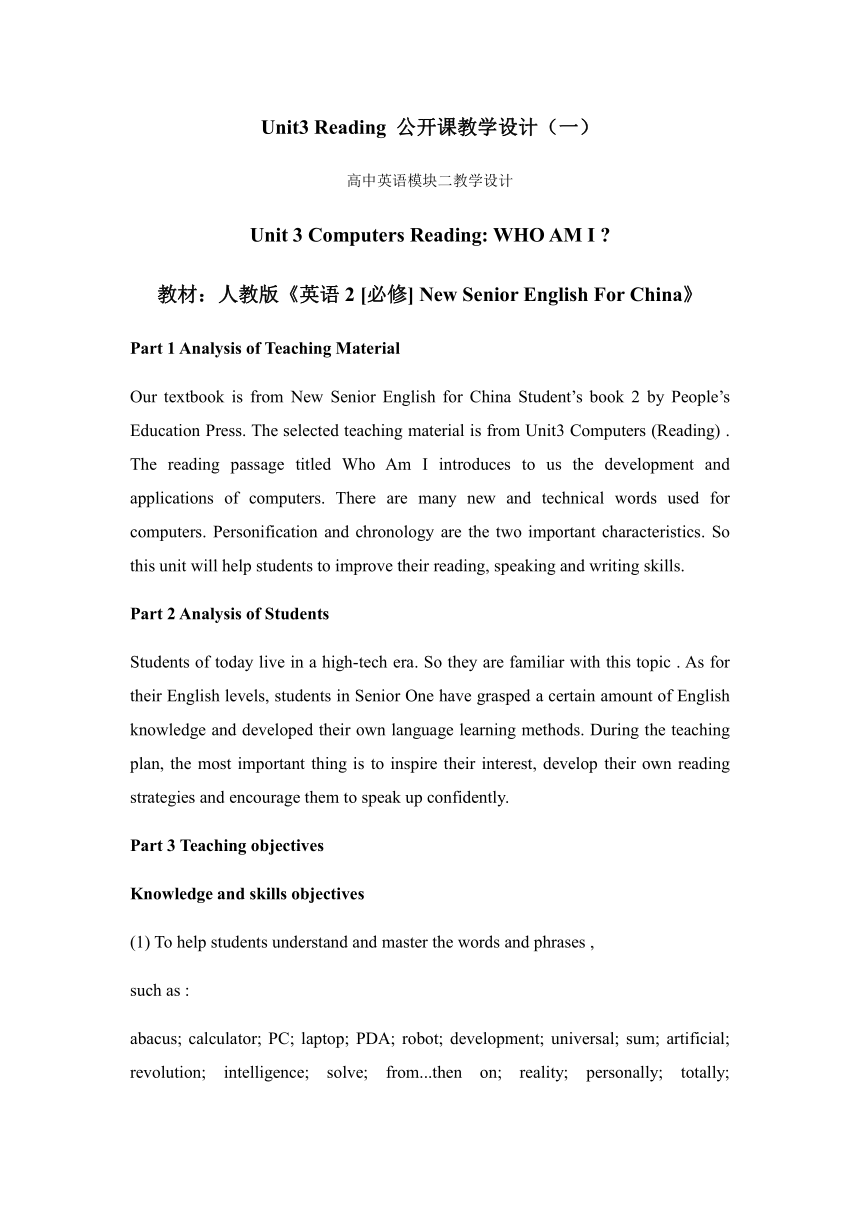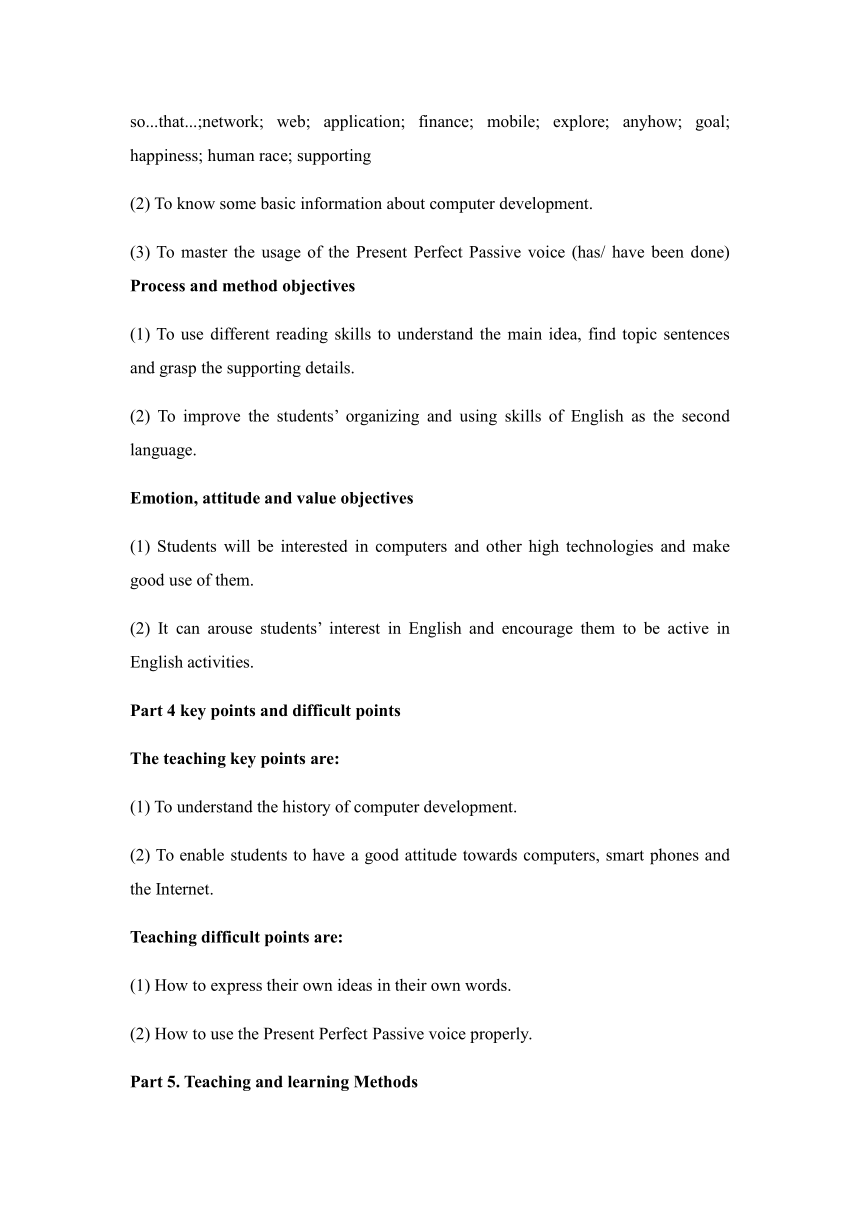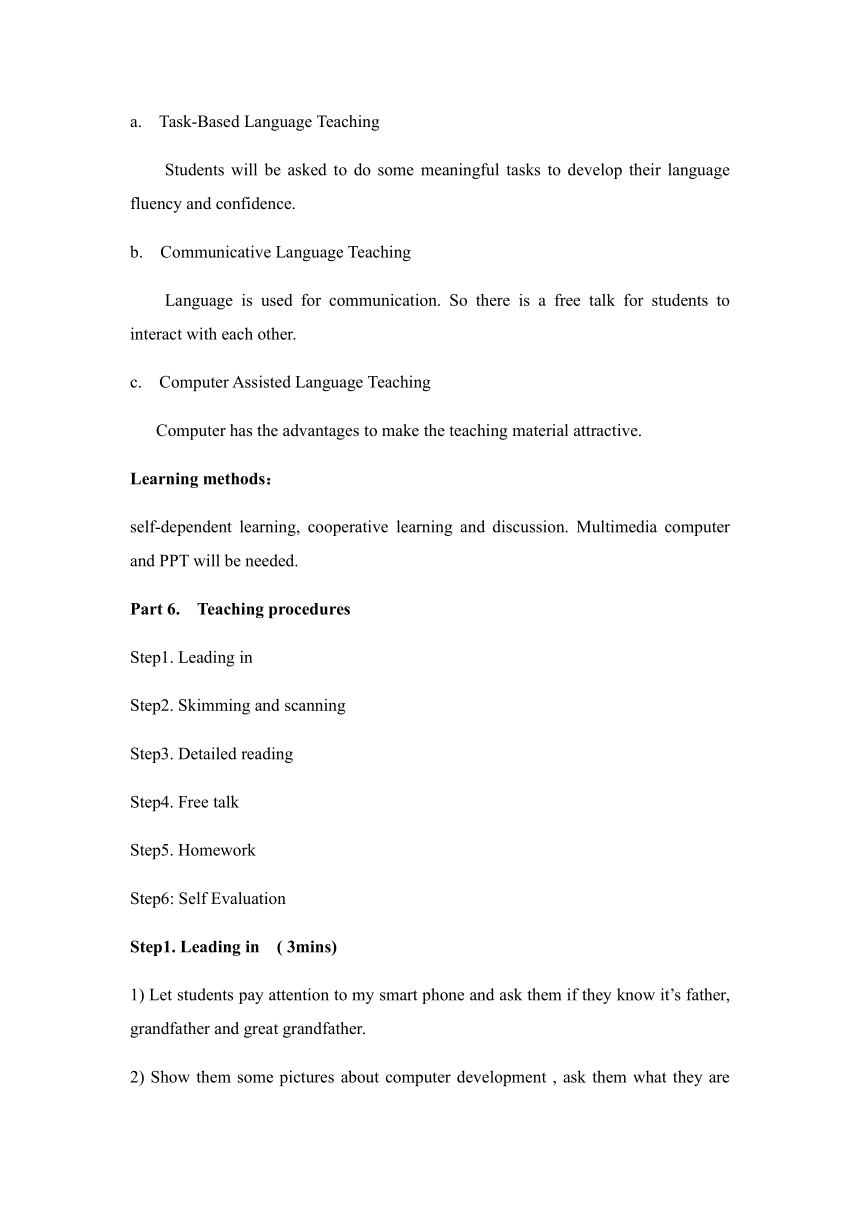人教版必修二Unit 3 Computers Reading 公开课教学设计
文档属性
| 名称 | 人教版必修二Unit 3 Computers Reading 公开课教学设计 |  | |
| 格式 | zip | ||
| 文件大小 | 91.5KB | ||
| 资源类型 | 教案 | ||
| 版本资源 | 人教版(新课程标准) | ||
| 科目 | 英语 | ||
| 更新时间 | 2019-12-11 10:32:17 | ||
图片预览



文档简介
Unit3 Reading 公开课教学设计(一)
高中英语模块二教学设计
Unit 3 Computers Reading: WHO AM I ?
教材:人教版《英语2 [必修] New Senior English For China》
Part 1 Analysis of Teaching Material
Our textbook is from New Senior English for China Student’s book 2 by People’s Education Press. The selected teaching material is from Unit3 Computers (Reading) . The reading passage titled Who Am I introduces to us the development and applications of computers. There are many new and technical words used for computers. Personification and chronology are the two important characteristics. So this unit will help students to improve their reading, speaking and writing skills.
Part 2 Analysis of Students
Students of today live in a high-tech era. So they are familiar with this topic . As for their English levels, students in Senior One have grasped a certain amount of English knowledge and developed their own language learning methods. During the teaching plan, the most important thing is to inspire their interest, develop their own reading strategies and encourage them to speak up confidently.
Part 3 Teaching objectives
Knowledge and skills objectives
(1) To help students understand and master the words and phrases ,
such as :
abacus; calculator; PC; laptop; PDA; robot; development; universal; sum; artificial; revolution; intelligence; solve; from...then on; reality; personally; totally; so...that...;network; web; application; finance; mobile; explore; anyhow; goal; happiness; human race; supporting
(2) To know some basic information about computer development.
(3) To master the usage of the Present Perfect Passive voice (has/ have been done) Process and method objectives
(1) To use different reading skills to understand the main idea, find topic sentences and grasp the supporting details.
(2) To improve the students’ organizing and using skills of English as the second language.
Emotion, attitude and value objectives
(1) Students will be interested in computers and other high technologies and make good use of them.
(2) It can arouse students’ interest in English and encourage them to be active in English activities.
Part 4 key points and difficult points
The teaching key points are:
(1) To understand the history of computer development.
(2) To enable students to have a good attitude towards computers, smart phones and the Internet.
Teaching difficult points are:
(1) How to express their own ideas in their own words.
(2) How to use the Present Perfect Passive voice properly.
Part 5. Teaching and learning Methods
a. Task-Based Language Teaching
Students will be asked to do some meaningful tasks to develop their language fluency and confidence.
b. Communicative Language Teaching
Language is used for communication. So there is a free talk for students to interact with each other.
c. Computer Assisted Language Teaching
Computer has the advantages to make the teaching material attractive.
Learning methods:
self-dependent learning, cooperative learning and discussion. Multimedia computer and PPT will be needed.
Part 6. Teaching procedures
Step1. Leading in
Step2. Skimming and scanning
Step3. Detailed reading
Step4. Free talk
Step5. Homework
Step6: Self Evaluation
Step1. Leading in ( 3mins)
1) Let students pay attention to my smart phone and ask them if they know it’s father, grandfather and great grandfather.
2) Show them some pictures about computer development , ask them what they are and put them into right order.
Purpose: to arouse students’ interest at the beginning of the class and introduce the topic, which will pave way for the reading part.
After this, students will be eager to something about the development of computers and this is the very time to naturally lead the class into Step 2.
Step2. Skimming and Scanning ( 5mins)
1.Who am I ? I am a ________.
2.Get the main idea of the passage.
The d_____________ and a___________ of computers. 3.Find out topic sentence of each paragraph. (Topic sentence: tells the main idea of a paragraph; It is usually the first or last sentence of a paragraph.)
Purpose: In this step, I use Task-based Language Teaching method, which can give students a clear and specific purpose while skimming and scanning the context. The purpose is to inspire students to read actively, not passively.
Step3. Detailed reading ( 25mins)
1. Read Para. 1 and find out the development of computers.
1642:____________________________________________ 1822:____________________________________________ 1936:____________________________________________ 1940s:____________________________________________ Later:____________________________________________
Purpose: to let students have a thorough understanding of the computer development.
2. Read Para. 2 and find out how the memory has been improved. Purpose: to get the correct and useful information.
3. Read Para.3 and find some supporting details for the topic sentence .
Since the 1970s many new applications have been found for me. Purpose: Students should not only have a high speed of reading but also have a correct understanding of details.
4. Summary-Grammatical Blank Filling
I 1.________ (begin) as a calculating machine in 1642. It took nearly two hundred years 2.______ I was built as 3. ______analytical machine. I became a “universal machine” in 1936 4.______ (solve) any mathematical problem. I was very big at one time. However, with time 5.________ (go) by, I was made smaller and smaller. I was given a family 6._______(connect) by a network in the early 1960s. I was able 7._________(share) my knowledge with others 8.________ the World Wide Web.
I 9. __________(use) widely in many fields by now. I'm glad I am a 10. __________(devote) friend and helper of the human race.
Purpose: to consolidate what they have learnt today and put them into practice.
5. Question
What would your life be like without computers? Better or worse?
Step4. Free talk ( 10mins)
I’ll show them some pictures and a funny video about phubbers(低头族) and there are two questions for students to discuss and talk freely. What are the harmful effects of phubbing (低头症)? What should we do instead of being phubbers?
Then we’ll conclude our opinions. And I’ll show them another video about an advertisement for the International Day of Families, which will give students profound thinking.
Purpose: In this step, I use Communicative Language Teaching Method to improve students’ speaking abilities, which is an important language output. Let students know every coin has two sides and we shouldn’t become slaves of electronic devices.
Step5: Homework ( 1 min)
Design a poster for the International Day of Families: For love, no phone for an hour.
Step6: Self Evaluation ( 1 min)
Purpose: to evaluate themselves according to the chart to see whether they have achieved the teaching objectives.
Part7: The Blackboard Design
Part 8 Teaching Reflection
Students have achieved the teaching objectives.
1) They have known some basic information about computer development.
2) They can use different reading skills to understand the main idea, find topic sentences and grasp the supporting details.
3) Students have great interest in computers and other high technologies and make good use of them. However, students should be given more time to discuss and talk freely. And the blackboard should be designed better.
